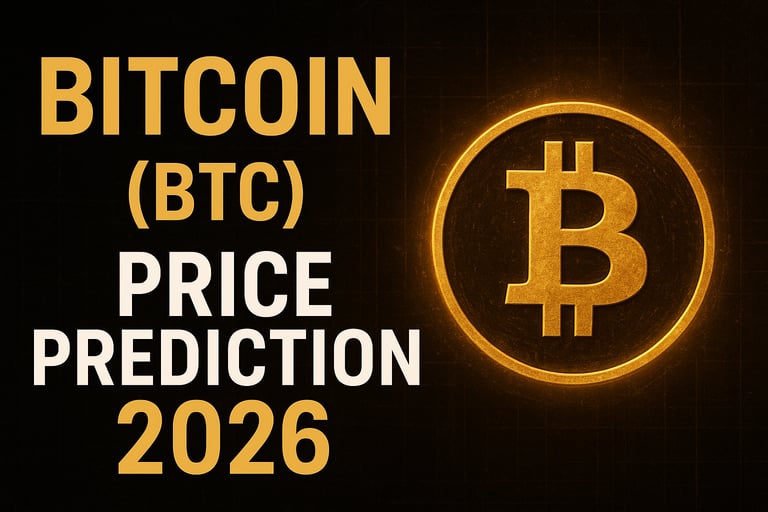Bitcoin (BTC) Price Prediction 2026 – The Complete Forecast with DropFinder
A deep, original exploration of where Bitcoin’s price could be by the end of 2026. I explain the supply-side and demand-side drivers (halving, ETFs, on-chain flows), macro tailwinds and risks, model-based scenario ranges (bear / base / bull), probabilities, and a practical checklist for investors and traders. This is analysis, not investment advice.
CRYPTO NEWS
10/11/20254 min read
Introduction
Bitcoin — the pioneer of cryptocurrency — has always been a symbol of innovation, volatility, and financial revolution. Since its inception in 2009, Bitcoin has seen tremendous growth, transforming from a few cents to tens of thousands of dollars. As we head toward 2026, investors, traders, and analysts are asking the same question: What will Bitcoin’s price be in 2026?
In this blog, we’ll take a deep dive into the potential Bitcoin price prediction for 2026, analyzing technical factors, macroeconomic indicators, historical patterns, and upcoming events that could shape its value.
A Brief History of Bitcoin’s Journey
Before diving into predictions, it’s essential to look at how Bitcoin has evolved over time.
2009–2012: Bitcoin was in its infancy, with prices below $1. Early adopters mined BTC through personal computers.
2013–2016: Bitcoin started gaining attention, crossing $1,000 for the first time. The first halving event in 2012 pushed prices upward.
2017: Bitcoin hit nearly $20,000, driven by retail investor frenzy and media hype.
2020–2021: After the COVID-19 pandemic, institutional investors entered the market. Bitcoin reached an all-time high near $69,000 in November 2021.
2022–2023: A massive correction occurred, driven by inflation, rising interest rates, and crypto market scandals like FTX. Bitcoin dropped below $20,000 at one point.
2024–2025: The next halving cycle and renewed optimism have reignited bullish momentum, setting the stage for a potentially explosive 2026.
The Role of the Bitcoin Halving
Bitcoin halving is one of the most crucial events influencing its price. Every four years, the block reward for miners is cut in half, reducing the rate of new Bitcoin entering circulation.
2012 Halving: Bitcoin rose from $12 to over $1,000 within a year.
2016 Halving: BTC climbed from $650 to nearly $20,000 in 2017.
2020 Halving: Bitcoin surged from $8,000 to $69,000 by 2021.
2024 Halving: This halving could set the stage for a major price rally through 2025 and into 2026.
Historically, the year following a halving tends to be bullish. That makes 2026 a potentially strong year for Bitcoin’s price performance.
Key Factors That Could Influence Bitcoin’s 2026 Price
Institutional Adoption
Institutional investors are increasingly embracing Bitcoin as a store of value and hedge against inflation. Major companies like MicroStrategy and Tesla have already invested heavily. If more corporations and financial institutions adopt Bitcoin, the demand could skyrocket by 2026.
Spot Bitcoin ETFs
The approval of Bitcoin Exchange-Traded Funds (ETFs) allows traditional investors to access BTC without holding it directly. The growing popularity of ETFs can drive more liquidity and legitimacy to the market, supporting a higher valuation in 2026.
Global Economic Climate
Economic instability, inflation, and currency devaluation often push investors toward decentralized assets like Bitcoin. If global economies continue to face inflationary pressure by 2026, Bitcoin could act as a digital safe haven.
Regulations and Legal Clarity
While regulations are often seen as barriers, clear and supportive frameworks can boost investor confidence. By 2026, many countries may adopt clearer crypto regulations, helping Bitcoin integrate with the traditional financial system.
Technological Developments
Bitcoin’s infrastructure continues to evolve. The Lightning Network is improving scalability and transaction speed, making BTC more practical for everyday use. Technological upgrades will likely strengthen Bitcoin’s utility and value over time.
Scarcity and Demand
With only 21 million BTC ever to exist, scarcity is Bitcoin’s core feature. As more people seek to own even a small fraction of Bitcoin, demand is bound to rise while supply diminishes.
Technical Analysis: Bitcoin’s Market Cycle
Bitcoin typically follows a four-year cycle tied to halvings:
Accumulation Phase (Bear Market): After a crash, prices stabilize.
Recovery Phase: Gradual price increase as interest returns.
Bull Run: Massive price surge driven by media attention and FOMO (Fear of Missing Out).
Correction Phase: Market cools down after overextension.
Given the 2024 halving, the accumulation phase (2022–2023) and early recovery (2024–2025) could lead to a bull run in 2026.
Bitcoin Price Predictions for 2026
Different experts and analysts predict varying scenarios for Bitcoin in 2026. Let’s explore some reasonable ranges based on market trends and potential outcomes.
Bullish Scenario
If Bitcoin continues its historical post-halving pattern, institutional adoption accelerates, and macroeconomic conditions favor digital assets, Bitcoin could easily surpass its previous all-time high.
Predicted Range: $150,000 – $250,000
Moderate Scenario
If the crypto market matures but grows steadily with healthy regulation and moderate adoption, Bitcoin may experience slower growth yet remain strong.
Predicted Range: $80,000 – $150,000
Bearish Scenario
If global regulations tighten, investor sentiment weakens, or economic crises strike, Bitcoin could face stagnation or decline.
Predicted Range: $40,000 – $60,000
Expert Opinions
Many analysts believe the 2026 bull market could outperform 2021 due to institutional demand and ETF inflows. Others caution that volatility will remain high. The key takeaway is that Bitcoin continues to be seen as a high-risk, high-reward asset that thrives on innovation and market cycles.
Macroeconomic and Geopolitical Impact
Inflation and Monetary Policy
Central banks worldwide are balancing inflation with interest rates. If fiat currencies weaken, Bitcoin could benefit as a hedge asset.
Geopolitical Tensions
Global uncertainty — wars, sanctions, or political shifts — often pushes investors toward decentralized systems. Bitcoin’s borderless nature makes it attractive during uncertain times.
Technological Competition
Although other cryptocurrencies (like Ethereum and Solana) continue to innovate, Bitcoin’s brand and first-mover advantage still make it the most trusted store of value in the crypto world.
Bitcoin in 2026: Beyond Price
While price prediction is exciting, Bitcoin’s future isn’t just about value — it’s about adoption and influence. By 2026, we may see:
Wider acceptance of Bitcoin payments across industries.
More countries recognizing Bitcoin as legal tender or regulated digital property.
Increased mainstream education around self-custody and blockchain technology.
Cross-border remittances becoming faster and cheaper with BTC.
Potential Risks to Watch
Regulatory Crackdowns: Sudden government actions could impact price and sentiment.
Technological Flaws: Though rare, network vulnerabilities could disrupt confidence.
Market Manipulation: Whales and large institutions may influence prices.
Environmental Concerns: Bitcoin mining continues to face criticism for energy consumption.
Competition: Emerging blockchain projects could attract investors away from Bitcoin.
Bitcoin 2026 Forecast Summary
Bullish Scenario: $150,000 – $250,000 (Strong adoption, ETF inflows, favorable economy)
Moderate Scenario: $80,000 – $150,000 (Gradual growth with healthy regulation)
Bearish Scenario: $40,000 – $60,000 (Weak economy, heavy regulation, or reduced demand)
The Long-Term Outlook
Looking beyond 2026, Bitcoin is likely to remain the dominant digital asset. As new halvings occur, scarcity will push its value upward. With time, Bitcoin could evolve into a global reserve-like asset, coexisting with traditional finance systems rather than replacing them.
Final Thoughts
Predicting Bitcoin’s exact price in 2026 is impossible — but understanding its trends, cycles, and macroeconomic factors can help us make educated forecasts. Based on historical data, Bitcoin could realistically trade between $80,000 and $250,000 by 2026, depending on global adoption and market sentiment.
What’s certain is that Bitcoin’s journey is far from over. As technology, adoption, and regulation evolve, Bitcoin will continue shaping the financial future of the world.
Reference: DropFinder — Your trusted guide for crypto insights and future trends.




